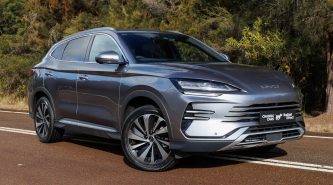MG QS Essence 2025 review
Looking to address gaps in its range on the way to sales domination, MG has rushed its new seven-seat QS to market
Looking at sheer sales numbers, MG is doing well in Australia, though in the first half of 2025 it has slipped behind a fast-rising GWM in the local leading-brands chart.
New, diverse product is always a good market trick to stem a sales deceleration, and that’s exactly what MG is doing, speedily plugging gaps in its range. The QS is the latest gap-plug for the British-named, Chinese-owned brand.
Targeting the Hyundai Santa Fe, Toyota Kluger and Kia Sorento, the MG QS is going after big Australian families with three rows and space for seven in its near-five-metre body.
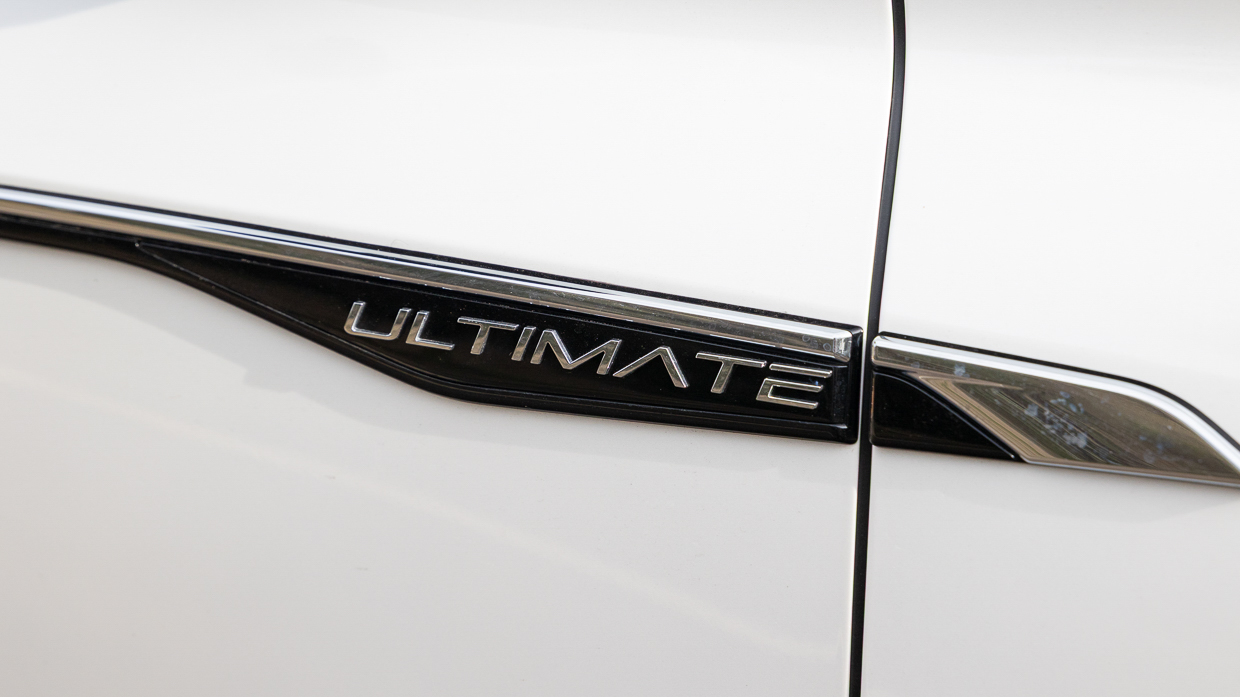
It even has ‘ULTIMATE’ in chrome on the guards, despite that carrying absolutely no meaning in the Australian market, where MG sells two trims known as Excite and Essence.
The question is whether the QS can deliver a convincing overall package that can help overlook its chintzy appearance.
What are the QS Essence’s features and options for the price?
The MG QS arrives in Australia in two trims: entry-level Excite and top-spec Essence. Both use a 2.0-litre turbo-petrol four-cylinder developing 153kW and 360Nm, the key difference being driven wheels and level of equipment.
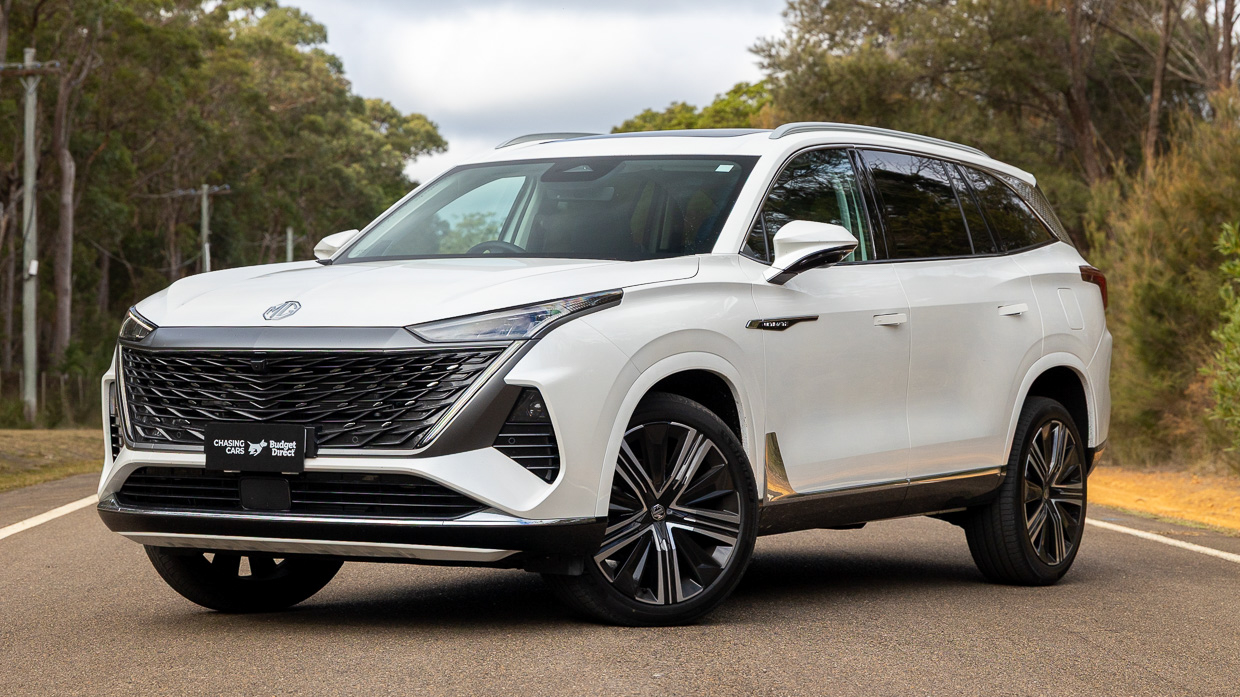
The Excite is front-drive only and is on offer at $46,990 driveaway nationally. Moving up to the Essence is $4000 well spent in our book, adding the security of all-wheel drive along with adaptive dampers.
Below is a list of features in the QS Essence, with bold text denoting an upgrade over the Excite.
- 21-inch alloy wheels
- LED headlights
- Auto highbeam
- Customisable welcome greeting
- Keyless entry w/ push-button start
- Synthetic leather-appointed steering wheel
- 256-colour ambient lighting
- Panoramic, opening sunroof
- Tri-zone climate control
- Heated rear windows
- 12.3-inch digital driver’s display
- Navigation with cluster display
- 12.3-inch multimedia touchscreen
- Wireless Apple CarPlay and Android Auto
- 12-speaker Bose stereo
- Wireless charging pad
- Front parking sensors
- Perforated leather-faced upholstery
- Heated and ventilated seats
- Heated steering wheel
- Eight-way power-adjustable front seats
- Power tailgate
- Adaptive dampers
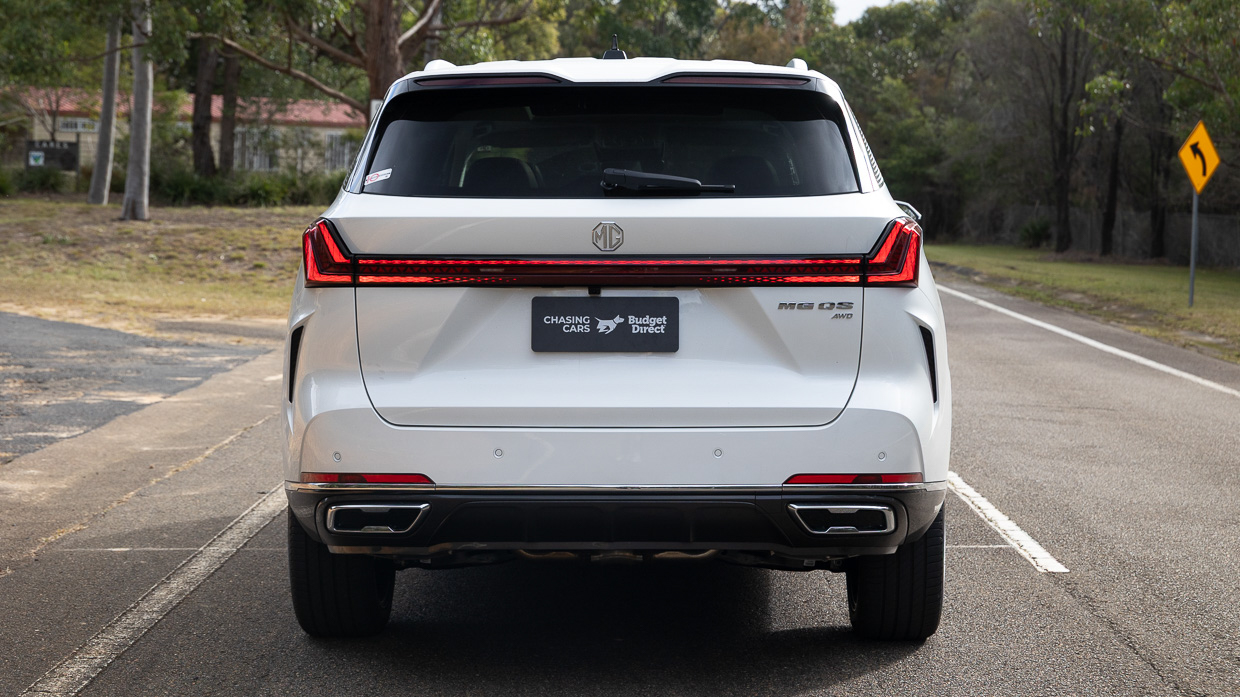
And if you’re thinking those prices sound like they’re from a decade ago, it’s because they are. Seven-seat large SUVs are dear these days. There’s an exception in the $38,990 driveaway Chery Tiggo 8 Pro Max, but it is much smaller, measuring more than 26cm (263mm) shorter than the 4983mm-long QS.
Really, then, the QS competes with the Hyundai Santa Fe (from $53,000), Nissan Pathfinder ST-L ($59,945), Kia Sorento S ($50,880) and rather expensive Toyota Kluger GX hybrid ($62,140). (Prices listed before on-road costs and current as of mid 2025.)
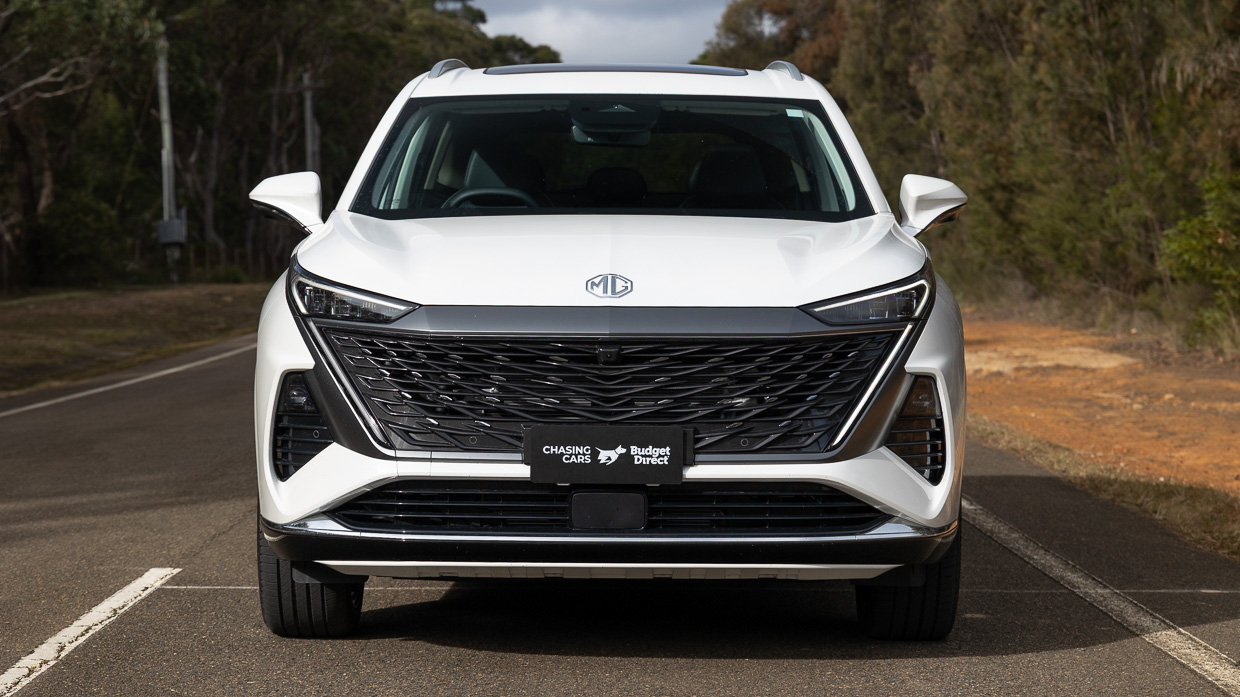
Each of those rivals has more polish and greater breadth of choice including eight-seat (Pathfinder) and hybrid (the others) options, though. BYD’s upcoming three-row Sealion 8 plug-in hybrid may be worth waiting for, however.
How does the QS Essence drive?
There’s some excellence in the QS Essence driving experience, exceeding our class benchmark Hyundai Santa Fe in terms of ride sophistication and road-holding. It’s a shame that level of polish is so fleeting, leaving the QS feeling deeply unfinished.
The secret is the Essence’s adaptive dampers. A total of six drive modes can be cycled through with a rotary selector, including Auto, Eco, Custom, Sport, Snow and Off-road. And in Auto or Eco, the way the QS breathes with the road and controls its considerable 2030kg mass is very impressive.
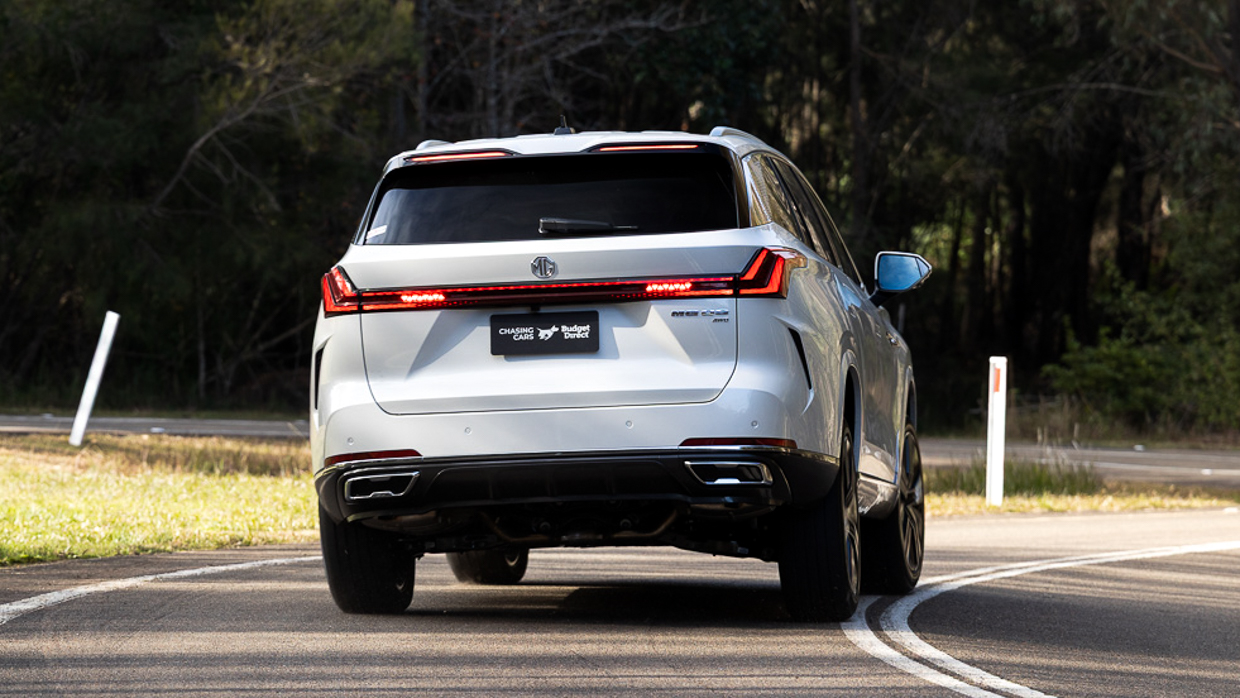
Doubly so because the QS rides on huge 21-inch alloy wheels, which are wrapped in quality 255/45 R21 Michelin Primacy E EV-targeted tyres. That said, the ride on 19s would have been even better along with minimising road noise and the QS’s pronounced bump-thump.
Choosing good tyres and having trick dampers means the QS corners flat and handles well, enabling a small amount of adjustment through the rear end you’d never expect in a big bus like this.
But this is where effusive praise for MG’s new seven-seater ends, because the rest of the driving experience is flawed. The 2.0-litre engine’s note is hollow and buzzy, especially from cold.
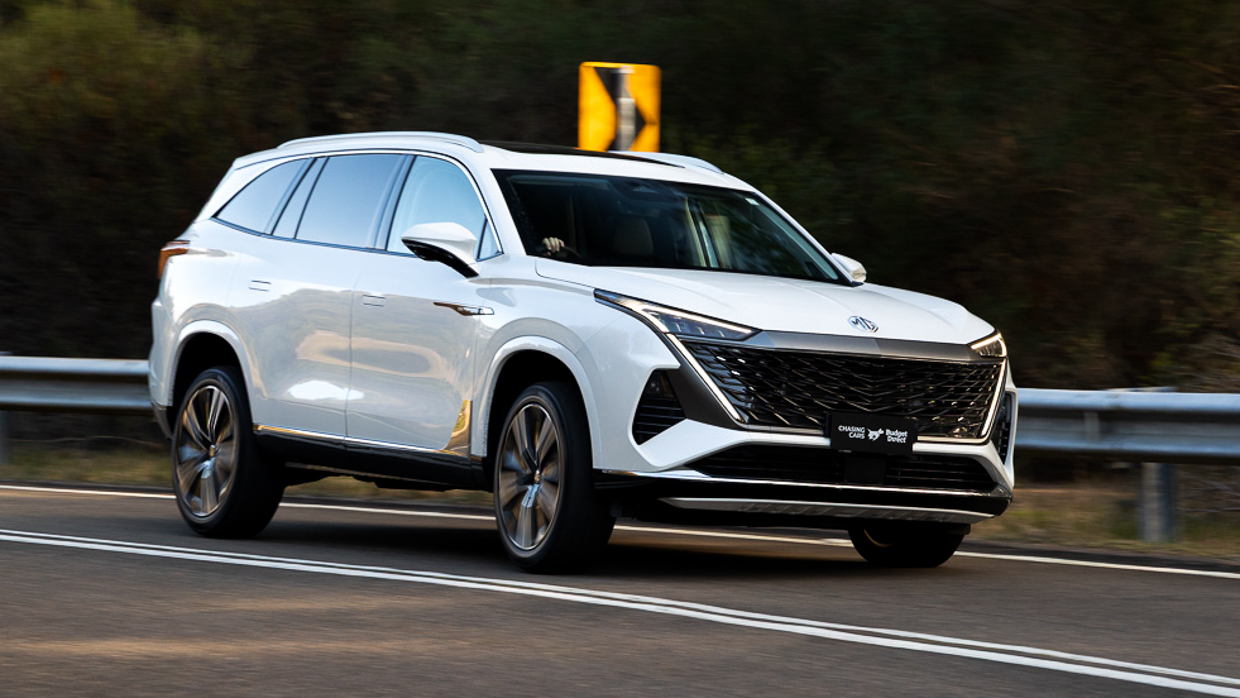
The QS’s nine-speed automatic transmission is recalcitrant and clunky, always going for the highest ratio when cruising, blunting response. It gets lost when the lights go from red to green as you’re coasting towards them and clunks into a low gear.
Then there’s the lag off the line. With the auto stop-start system left on, you’re waiting almost two seconds before anything meaningful happens (and which got me a toot from a car behind on one occasion).
Part of the problem is the MG’s power delivery. The peaky 2.0-litre has to work hard to reach its 153kW and 360Nm maximum outputs, so it never feels effortless unlike the Hyundai Santa Fe’s tractable 2.5. The QS managed to get from 0-100km/h in 8.9 seconds in our testing, which is on the slow side these days.
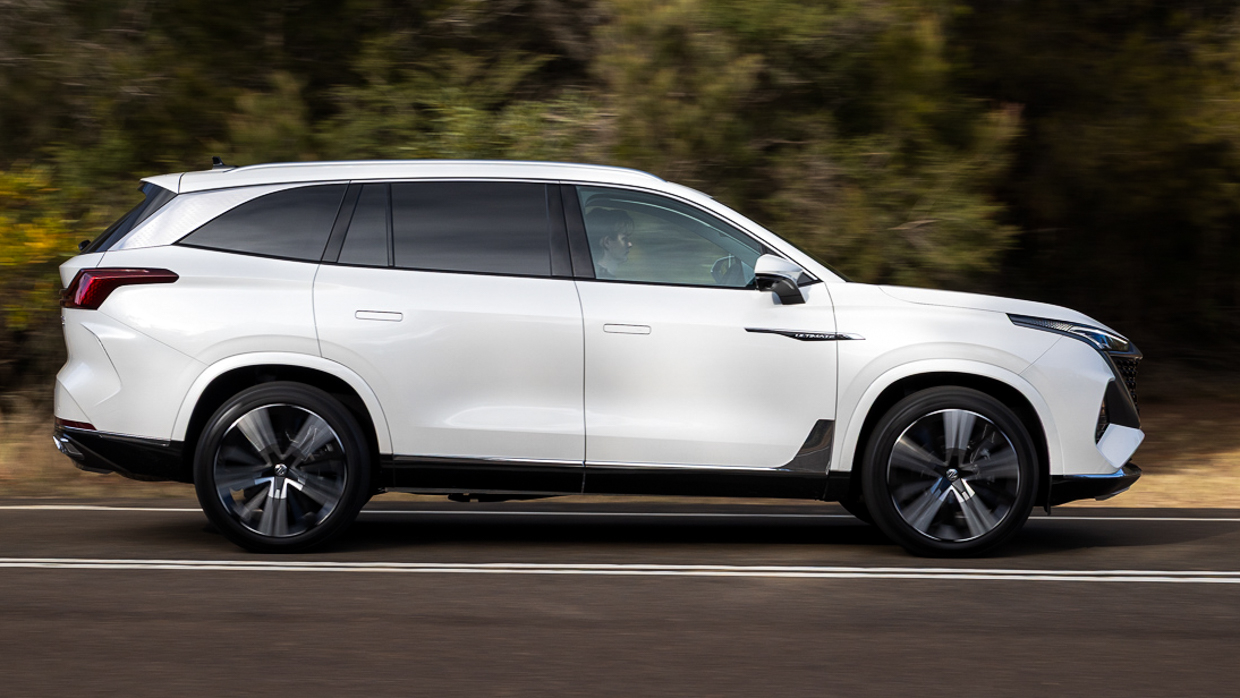
While on performance testing, the QS did shine in passive safety. The body remains poised under heavy braking and evasive manoeuvres, too. The QS posted a strong 100-0km/h stopping distance (34.75 metres) and kept a predictable pedal feel over three hard stops.
It’s a mixed bag, the QS, but rather than the impressive damping, it’s the lows of a lazy powertrain and noisy cabin that you remember most.
What is the QS Essence’s interior and tech like?
Labelling the QS a family bus is pretty accurate, especially when talking about the elevated driving position. With its steering wheel tilted away from the driver, pedals set close and a tall bonnet line, it also feels claustrophobic.
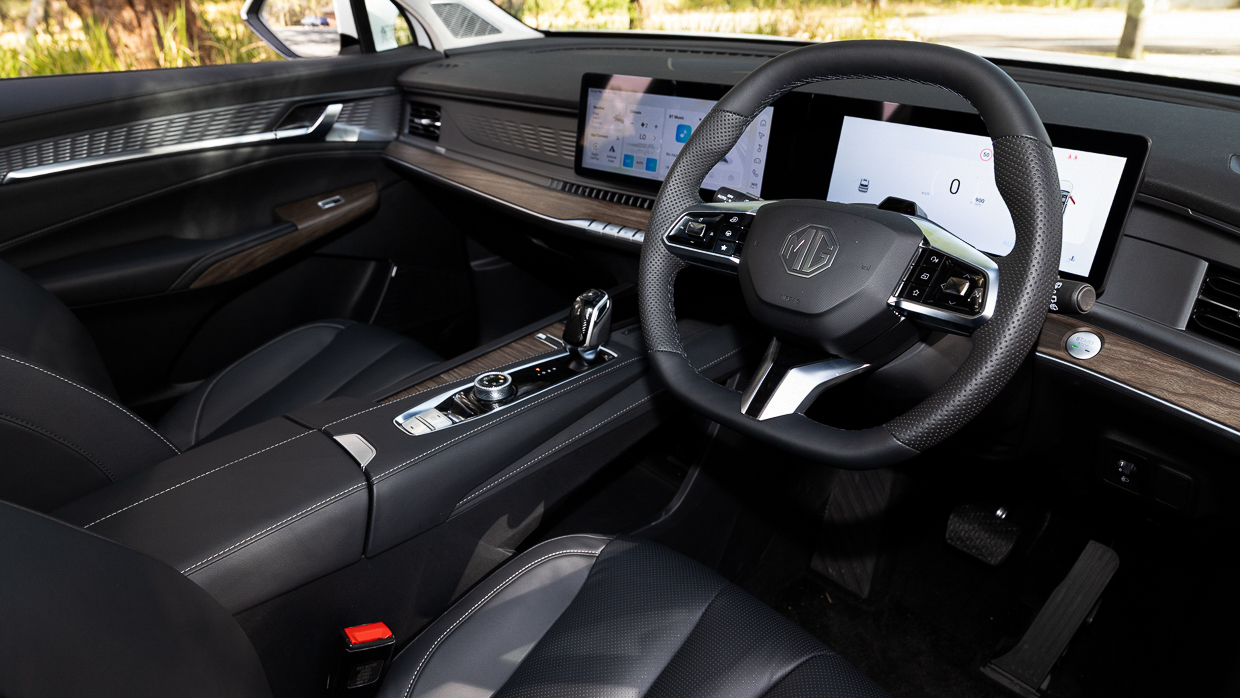
The perforated (real) leather seat facings are nice for $50K, even though the lazy-boy seats lack under-thigh and lateral support. That squishy feeling is common around the cabin, with soft dash and door topping and armrests giving a sense of new-luxury.
It’s a thin impression that breaks with the Bose 12-speaker sound system. MG seems to have purchased the speaker grilles and left the rest behind because the sound quality is disappointing, with a muddy bass and thin tone. The saving grace is that it goes really loud, if you like that kind of thing.
Where the QS really struggles is technology. The central touchscreen is a respectively sized 12.3-inch unit but MG has jammed everything in there. From key vehicle controls like safety systems to the climate adjustment, to the heated steering wheel and heated/ventilated front seats.
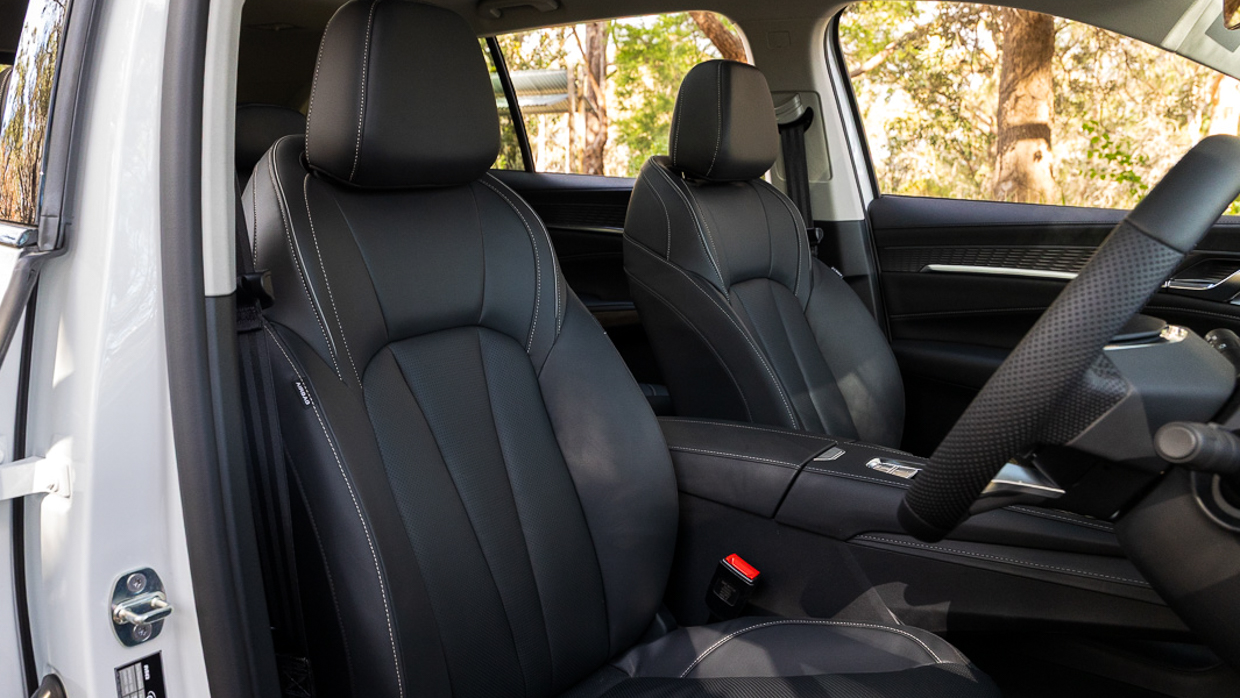
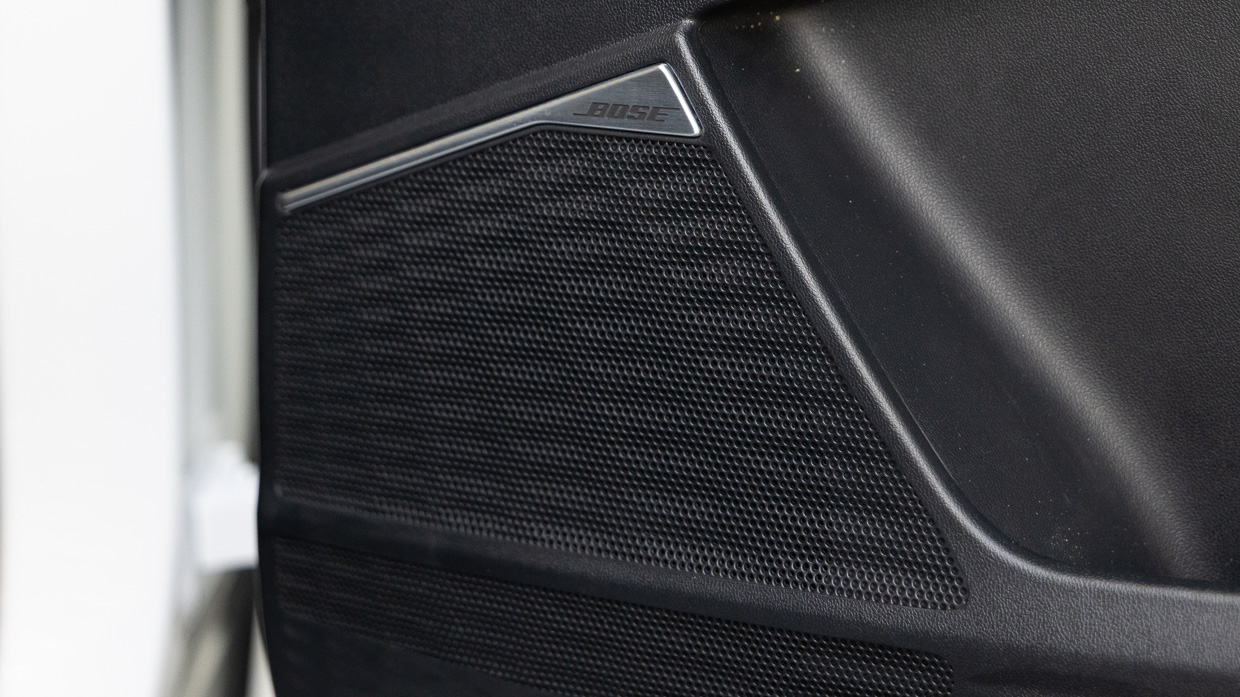
There’s a pull-down shortcut menu through which you can disable the lane-keep assist, auto stop-start and other features, but it isn’t customisable – meaning you need to tap four times from wireless phone mirroring to get to the heated seats.
Also, the direction of the central vents is adjusted through the touchscreen, like a knock-off Tesla Model Y. It might not be so bad if the QS had a responsive touchscreen, but the processor responds at random – mostly glacial – times. It’s tiring, distracting, and borderline dangerous.
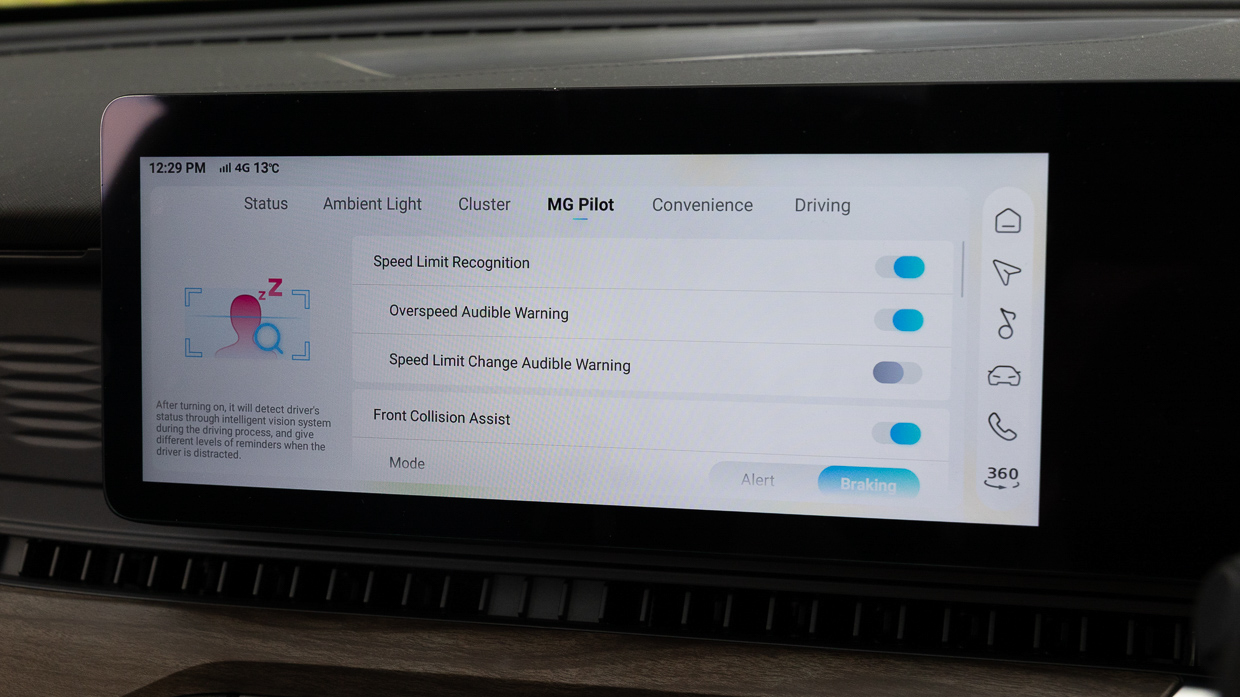
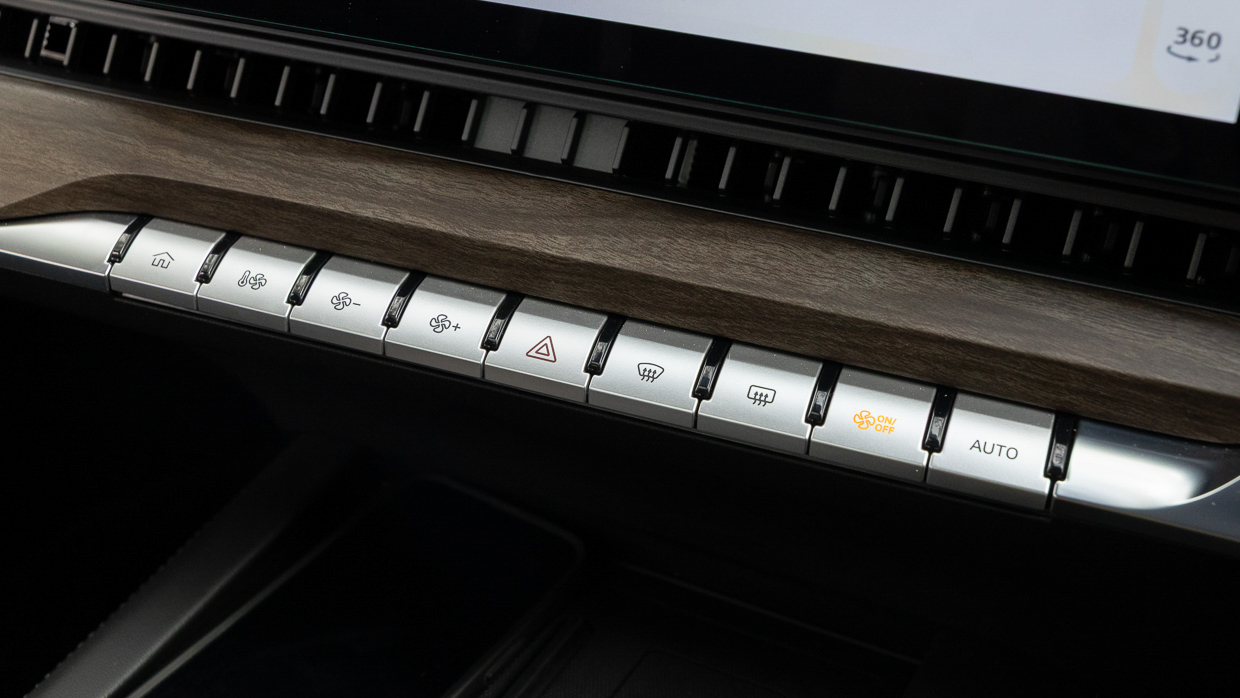
Front-seat storage is good, with a deep centre bin, door bins that accept small 600mL bottles, and two cup holders with pseudo-Formica roll-top cover. Beneath the shift-by-wire gear selector is a storage tray good for tissue boxes or handbags.
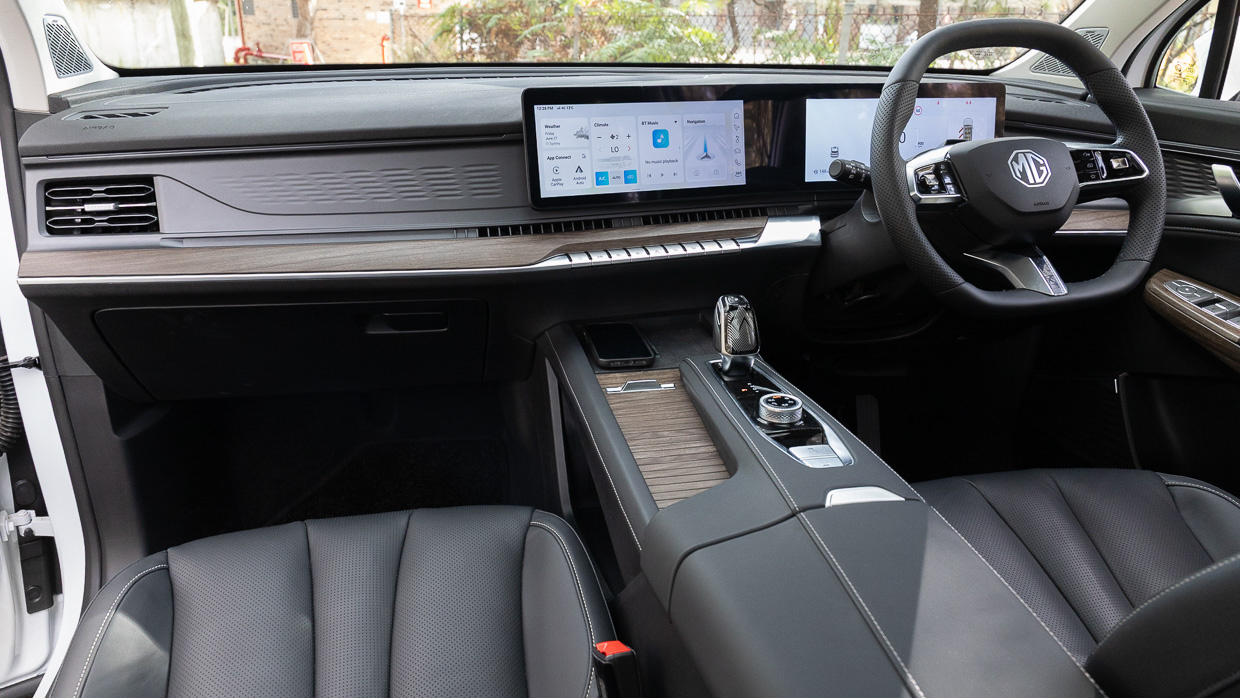
This is where you find the 12-volt socket and two USB-C fast-charge points. They’re on the passenger side, though, and nearly impossible for the driver to reach.
The MG QS offers good versatility, thanks to the 60:40 split second row being on sliders and offering generous backrest adjustment between 21 and 35 degrees of reclination.
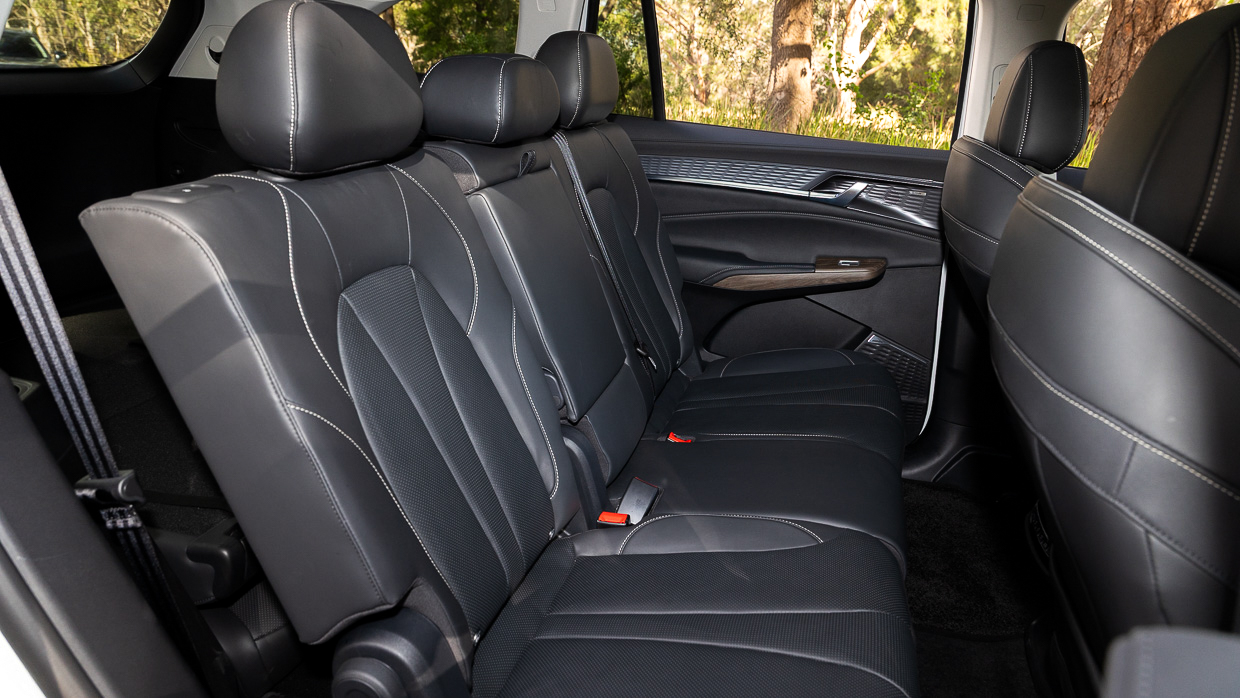
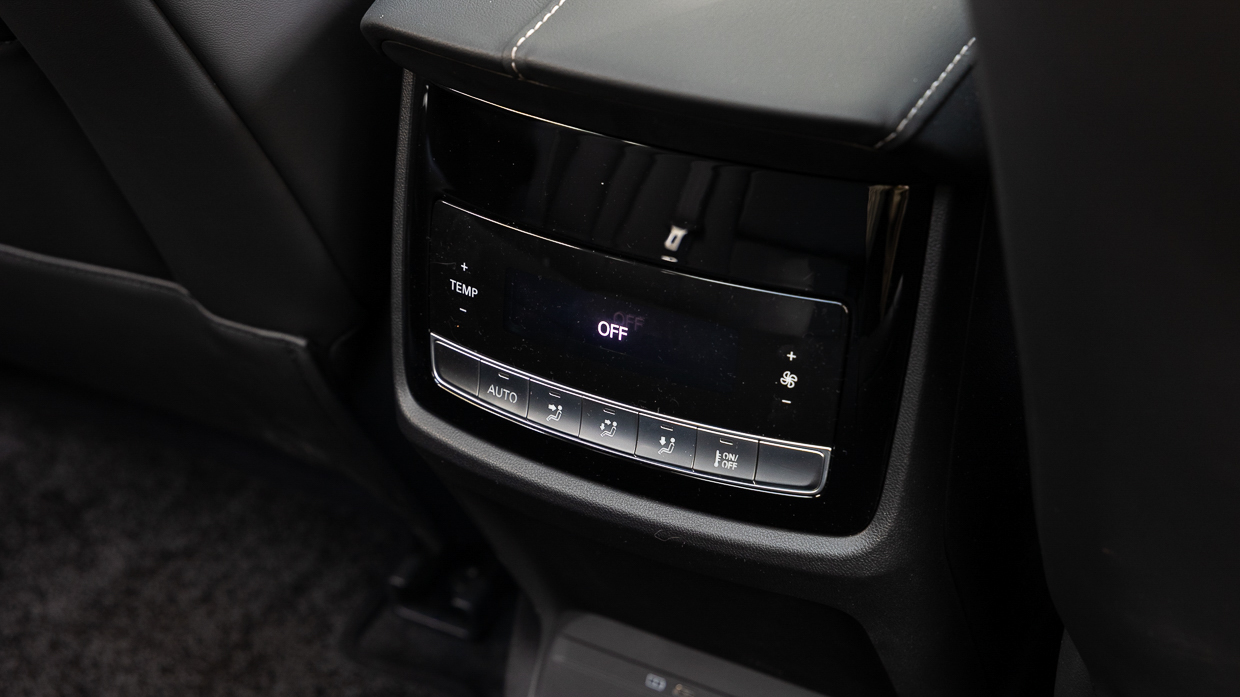
Mid-row passengers have plenty of headroom and loads of light through the standard panoramic sunroof. Flat floor, climate control, no heated seats, USB-C fast charge,
Material quality remains consistent in the second row with squidgy rubber capping on the doors. Door pockets are okay, and there’s a sturdy fold-out armrest in the middle that opens up with two cup holders.
Accessing the back seat is easy … providing no one has parked next to you. The QS’s doors are massive, longer than even a Mazda CX-80. This means getting in and out in even medium-tight carparks can be nearly impossible.
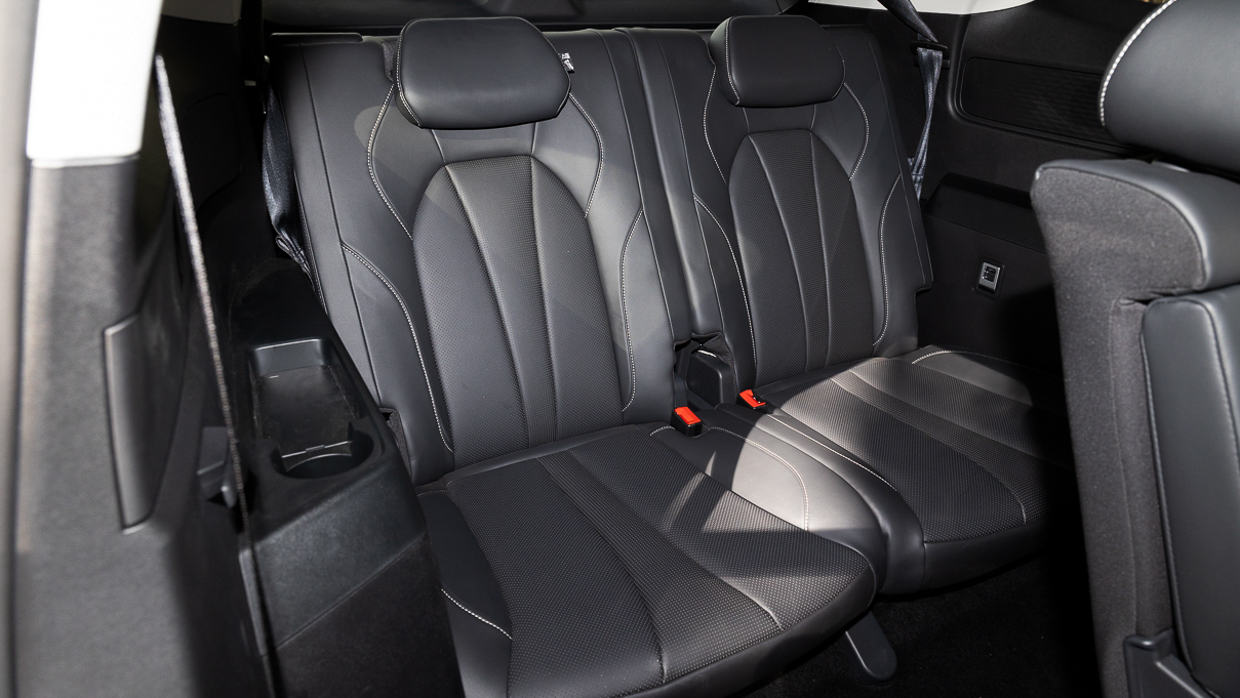
An electronically actuated fold-forward system for third-row access means it is easy for kids to get themselves into the QS’s third row. This is only on the driver’s side, though, so not the Australian kerb-side. The wider, heavier side of the bench has a regular, high-mounted latch.
MG chose not to bring the six-seat option with captain’s chairs that is offered in Chinese-market RX9s, and rivals in Oz, such as the Santa Fe.
The third row is easy to pull up out of the floor and space is respectable back there for adults over short distances. Vision out is better than the second row, and like in the middle there are roof-mounted vents, lights, cup holders, phone storage pockets and even a USB-A charger.
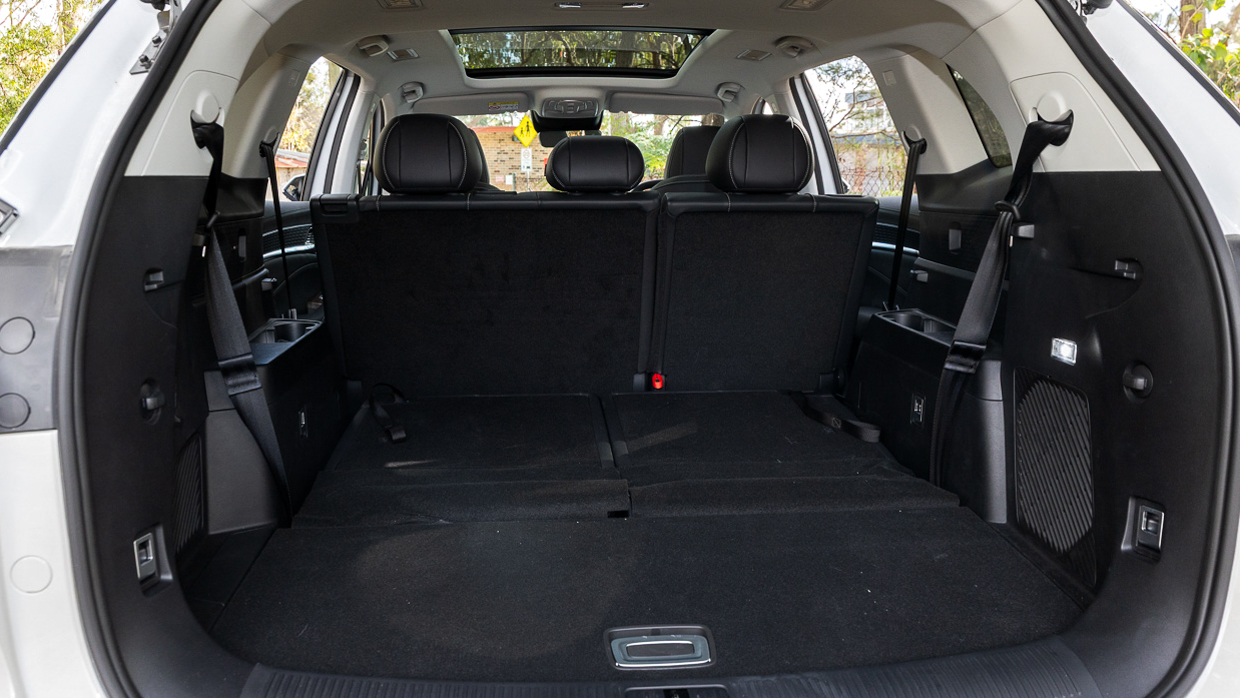
Boot space is impressive, measuring 207 litres with all three rows in place – practically, that’s enough space for backpacks on the school run or a small shop.
Folding the third row increases the space to a generous 517 litres; in van mode with two rows up that climbs to 1052L.
The QS’s wheelarches intrude into the space quite a lot, and the shape of the body means the cargo space isn’t particularly wide. We struggled with a mountain bike that easily fitted into the Hyundai Santa Fe.
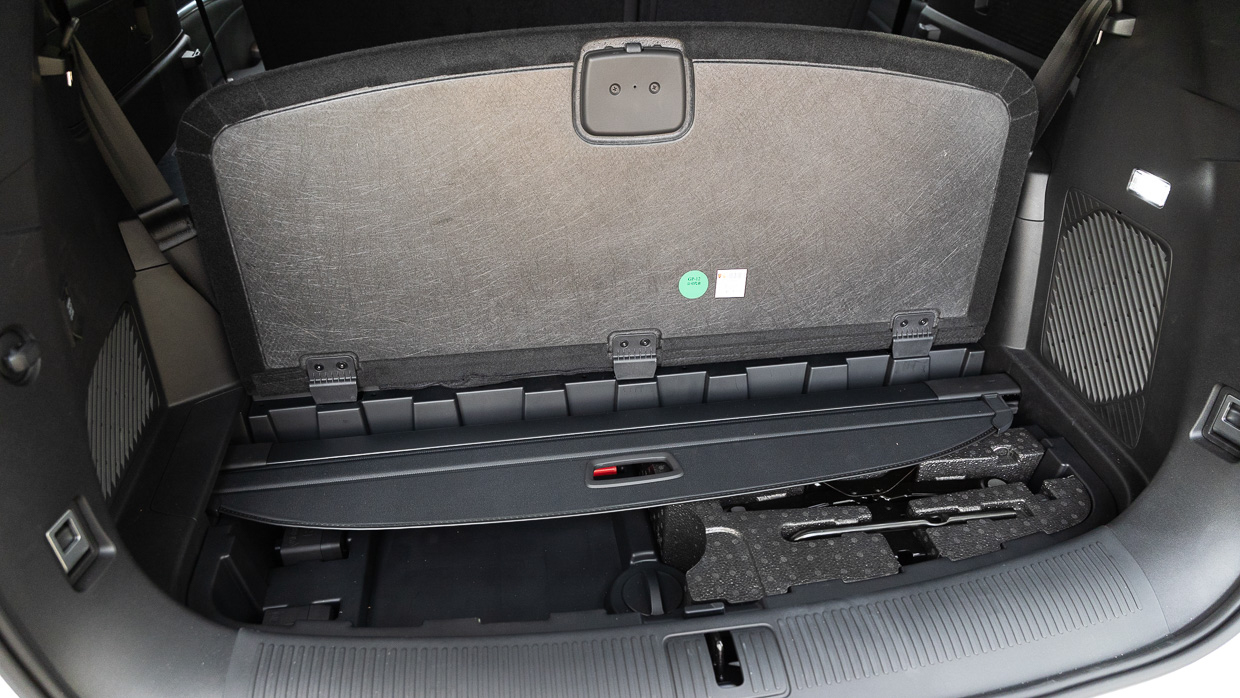
Amenities include a power tailgate, four tie-down points, cargo blind, two shopping bag hooks, and decent lighting. A sub-floor storage area houses the jack and a neat space for the cargo cover when not in use. It also doubles as a wet storage area.
The MG QS features a space-saver spare tyre slung under its rear end.
Is the QS Essence a safe car?
The MG QS has not been awarded a safety rating by ANCAP. Sold in China and the Middle East, ANCAP will have to crash the QS itself as it’s not available in Europe.
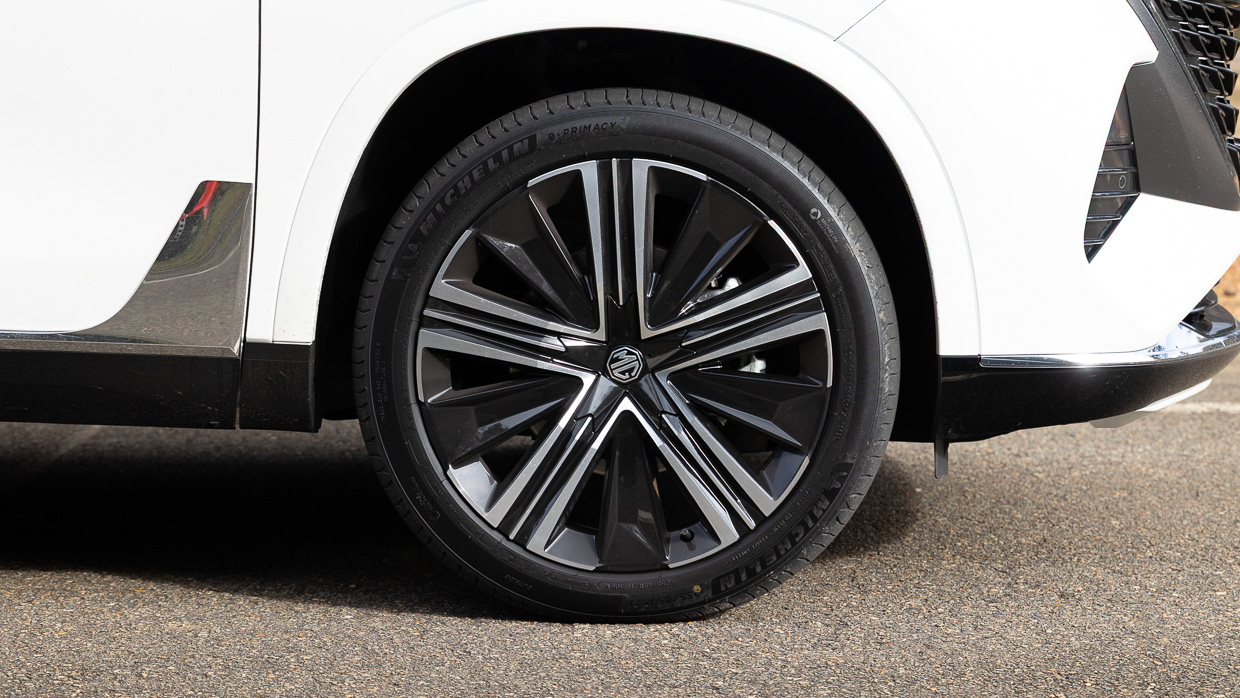
It is not short on safety and driver-assistance features, though….
Safety features are listed below
- Seven airbags, including front centre
- Forward auto emergency braking (AEB) with warning
- Lane-keep assist
- Lane-departure warning
- Blind-spot monitoring
- Rear cross-traffic alert with braking
- Adaptive cruise control with stop & go
- Front and rear parking sensors
- Driver-attention monitoring
- Speed limit assist
- Tyre pressure monitoring
The tuning of MG’s systems is improving and our QS test car mostly behaved itself. The speed limit assist was not always accurate and does default to beeping every time the car is turned on, but the sound wasn’t grating – turning it off through the laggy touchscreen is extremely tiring.
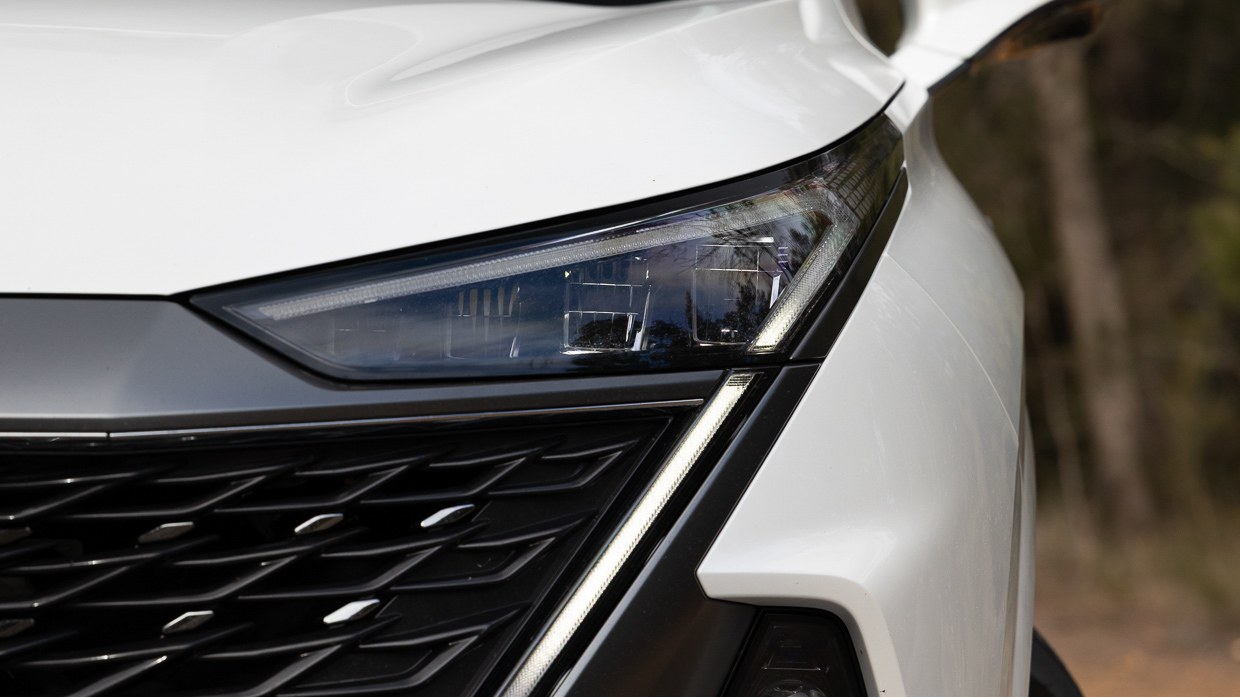
Lane-keep assist behaved itself generally, with only one phantom intrusion. MG needs to revise its adaptive cruise control tuning, which has too great a follow distance for Australian traffic and is inconsistent.
Much of the safety system is quite good, just annoying how you have to turn off using the laggy touchscreen.
More typical systems like the QS’s ABS and ESC – which includes a Sport mode – were mature.
What are the QS Essence’s ownership costs?
MG has recently updated its warranty offering, dropping it from a no-questions-asked 10-year/250,000km warranty.
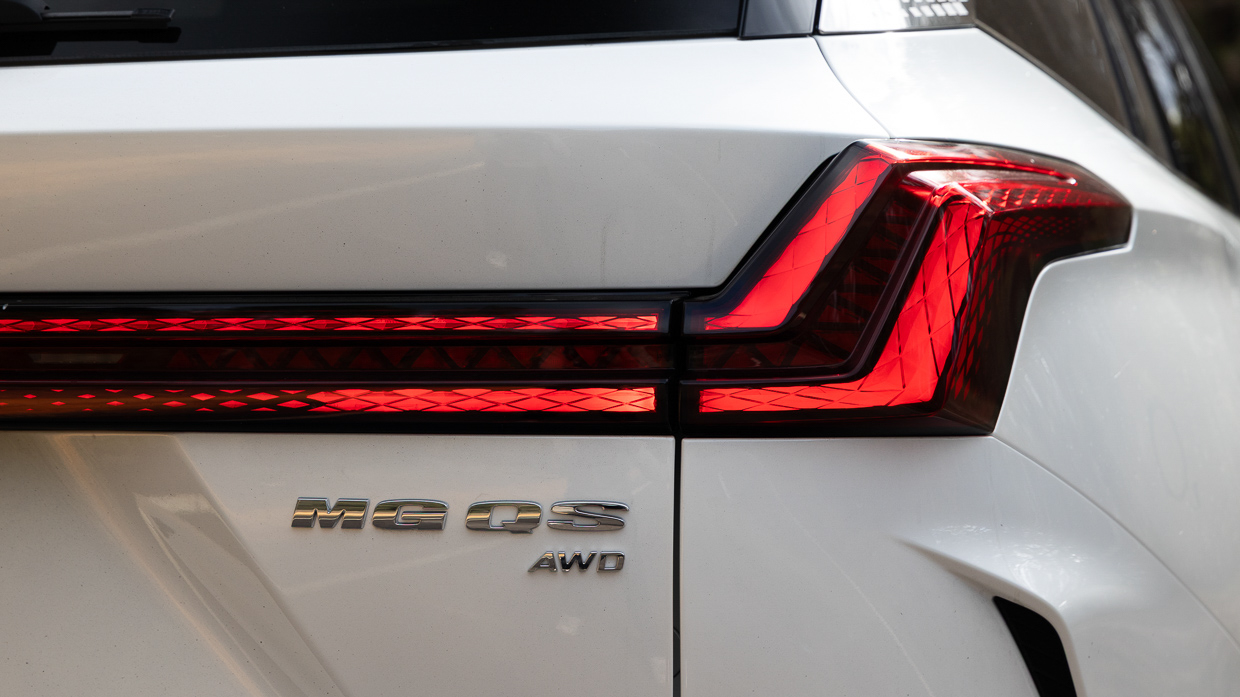
The MG QS is now covered by a seven-year, unlimited kilometre warranty with the option to extend that to 10 years if serviced on time at an MG dealer.
This equals Kia’s warranty, beats Hyundai’s, and is not dissimilar to Mitsubishi’s five-plus-five set-up. Nissan’s 10-year/300,000km warranty.
Servicing the MG QS is quite expensive, however costing $3618 over the first five years for the AWD model. Maintenance is due every 12 months or 15,000km — whichever comes first.
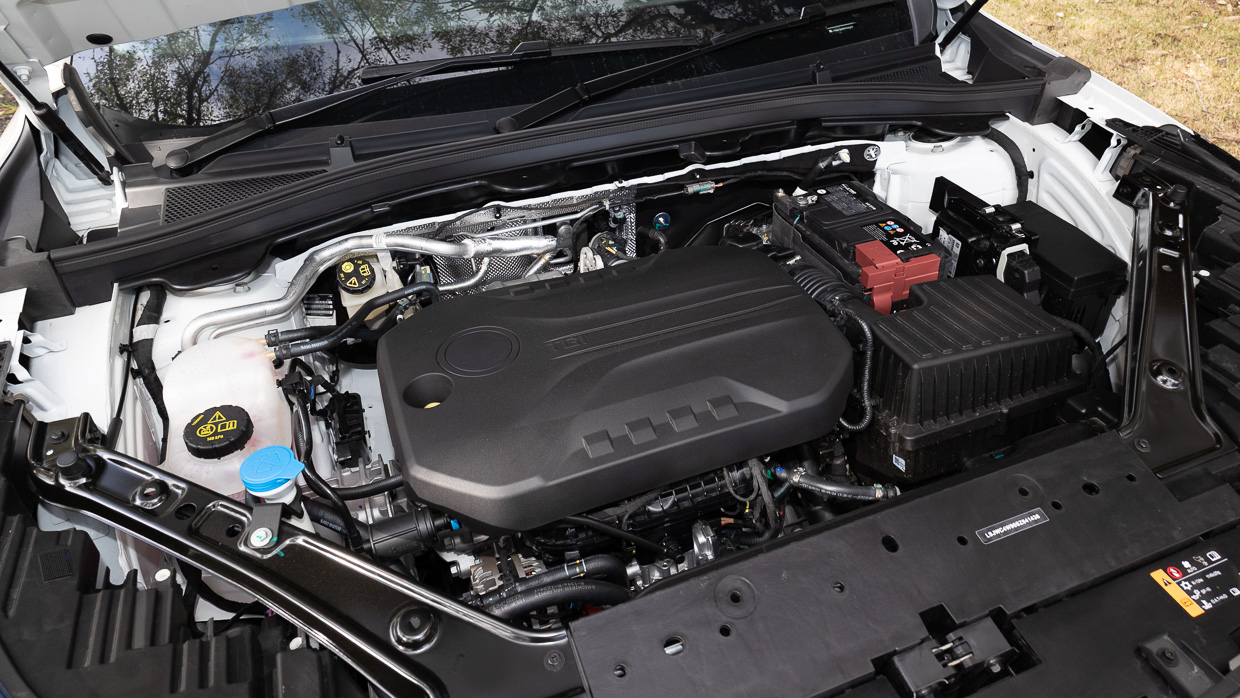
Buyers should be especially cautious looking at a five-year-old QS, though, because at six years/90,000km the MG dealership will sting your $2526 for maintenance on the AWD or wallet-emptying $2920 for the front-wheel drive. We would go quote-hunting at independent mechanics for that service.
Petrol costs will also be elevated in the QS, which requires 95 RON premium unleaded for its 2.0-litre turbo-petrol.
The book figure is 8.8L/100km for the Essence AWD we tested, but real-world driving saw that climb to 10.4L/100km, which was more than the gruntier Hyundai Santa Fe tested on the same route.
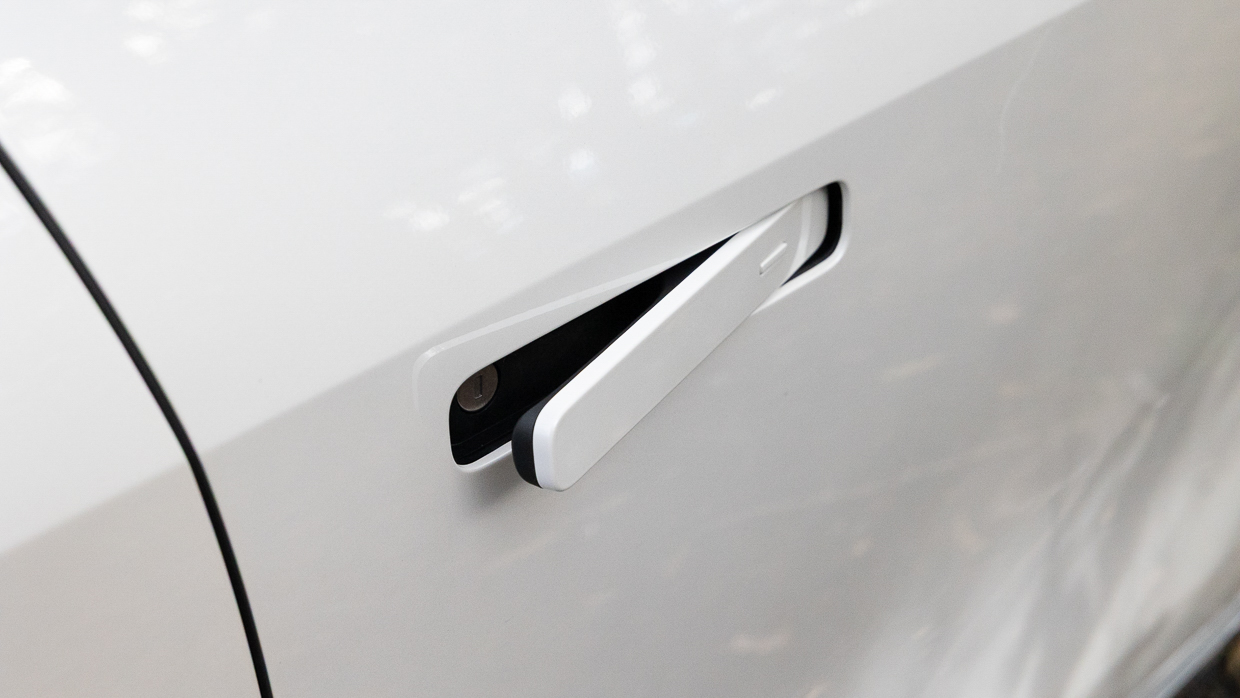
We noted the QS was very thirsty around town, regularly exceeding 13L/100km in urban running. MG does not yet offer a hybrid QS, but has not ruled out a future plug-in hybrid (PHEV) variant.
The honest verdict on the QS Essence
There are some glimmers of greatness in the QS. It offers remarkably sophisticated adaptive dampers, polished handling, and – most importantly for families – superb value in the seven-seater-SUV class.
Yet the more we lived with the QS, the more its laggy powertrain and technology drove us to distraction. It’s the sort of car that, strangely, impressed in a back-to-back comparison but was so frustrating to live with.
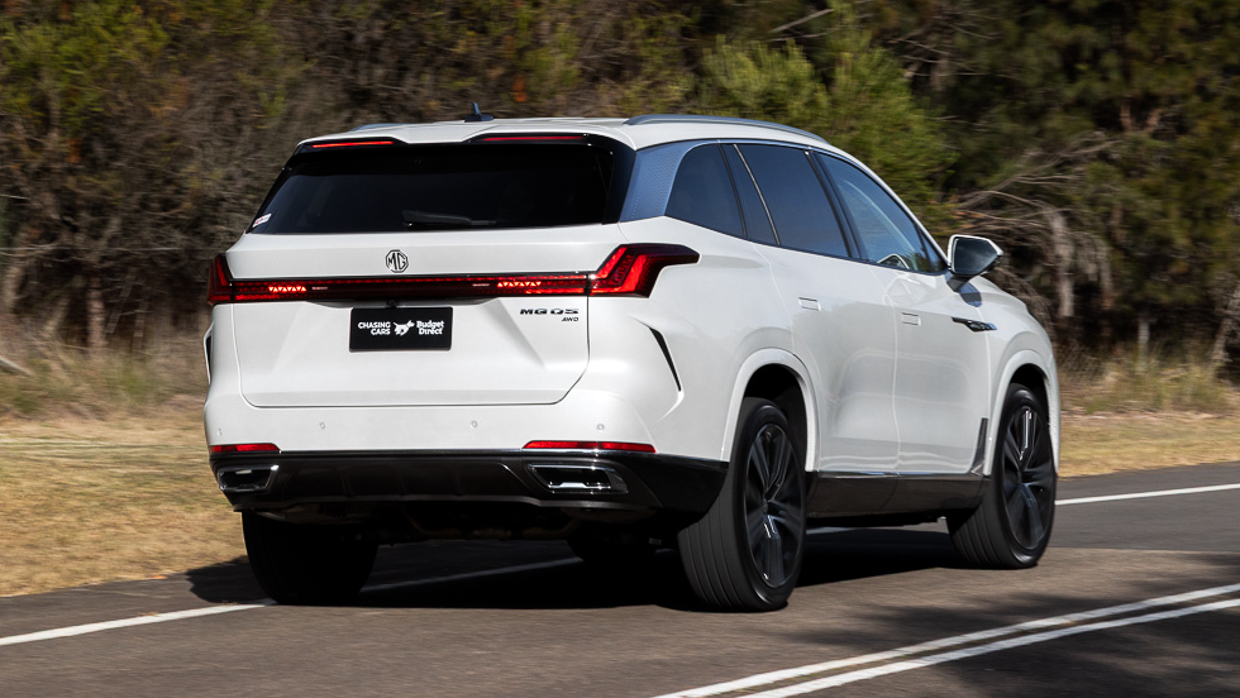
The QS lacks all-round polish and a sense of cohesion. It feels like a product rushed to market to urgently fill a product gap.
We know MG can do better: give the QS the slicker multimedia system from the S5 electric car, iron out the wrong-drive-side kinks – because the cabin is otherwise genuinely versatile – keep the price competitive, and this three-row SUV could shake up Kluger, Pathfinder, and even Santa Fe.
Overall rating
YD Sealion 5 2026: International first drive
3 months ago

John Law
Road Test Editor
Making plug-in hybrids even cheaper? The BYD Sealion 5 could arrive and change the game
Good points
- Potentially very affordable
- Well-built interior
- Solid EV stats
- Cohesive design
Needs work
- Light, vague steering
- Boot lacks features
- Ride needs work
- Could crowd BYD’s range
The big issue for plug-in hybrids from legacy brands such as Mitsubishi’s Outlanders and Ford’s defunct Escape PHEV was always price. You’d be paying $10,000 or more extra to get into these non-premium vehicles so you can have more efficiency — and so they never quite caught on.
China has arrived with lots of tech and cheap manufacturing, cutting prices of plug-in hybrids — or PHEVs — right down, below even some carmakers’ plugless self-charging hybrids. Now, BYD is mulling bringing an even more affordable midsizer Down Under in the Sealion 5.
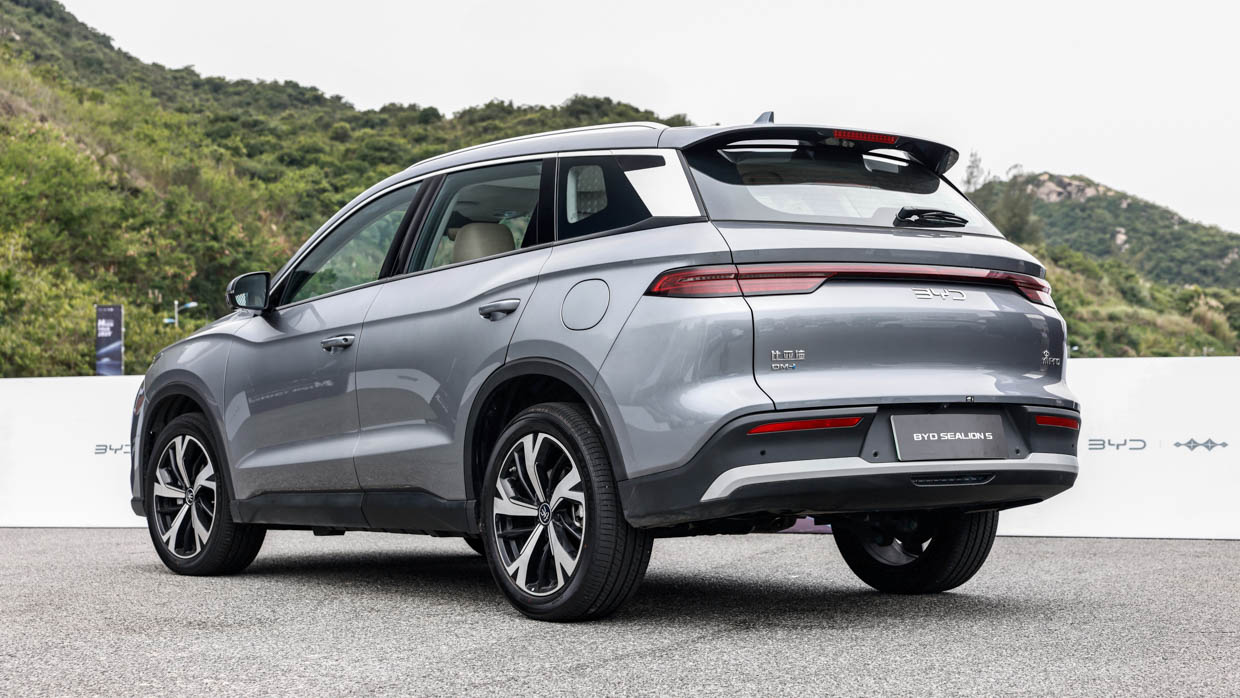
Chasing Cars spied the Sealion 5 — called the Song Pro in other markets — testing in Australia wearing blue and black camouflage, indicating the affordable midsize SUV is on the cards for local release. If it does come to Oz, it will follow the recently confirmed seven-seat Sealion 8 PHEV (or Tang L) plus the cut-price electric BYD Atto 2.
The addition of the Sealion 5 would certainly add confusion to an already crowded range. Remember, the Sealion 6 is just a little bigger than the 5, yet uses less impressive existing PHEV tech. And the Sealion 7? That’s an all-electric Tesla Model Y rival. And with the Sealion 5 about five centimetres shorter than the Sealion 6, it’s all very busy.
The Sealion 5 has a trump card: a likely sub-$40K starting price.
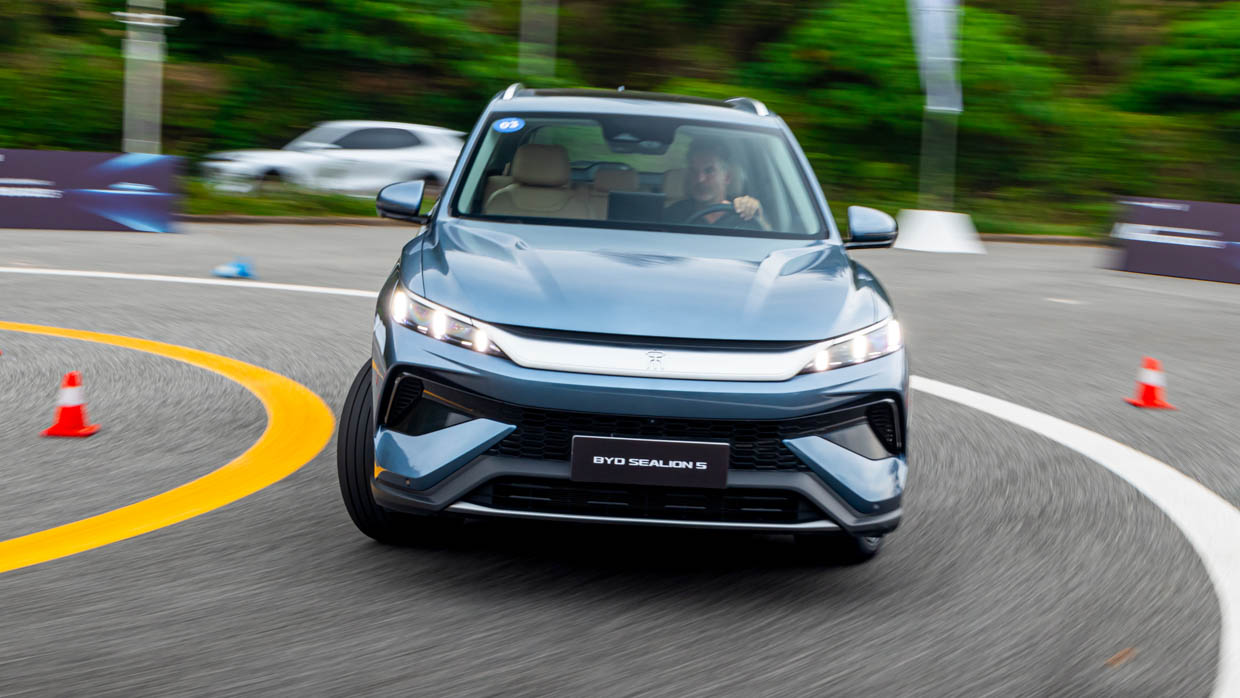
That’s right, a plug-in hybrid SUV with over 1300km (CLTC) driving range and 173kW able to sprint from rest to the speed limit in a little over 8.0 seconds, with wireless smartphone mirroring and a huge touchscreen for less than a parking-inspector-spec Toyota RAV4 GX.
Chasing Cars was flown to China to sample the BYD Sealion 5, along with a host of other products including the off-road-focused Denza B5. Our run-in with each car was brief but somewhat illuminating.
Naturally, the first question was of cannibalisation of Sealion 6 sales, and what the point of both models would be.
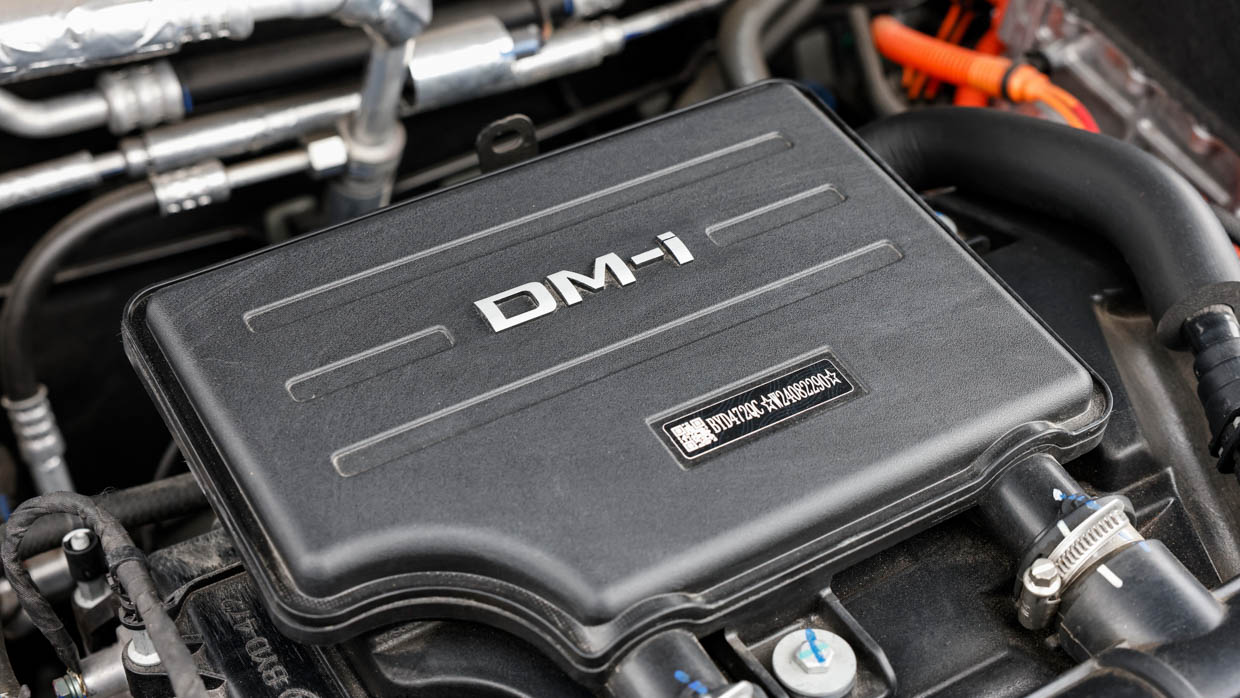
“It’s a medium-size SUV, it’s a plug-in hybrid, so definitely. I think there’s a huge love of medium-size SUVs and hybrids. [There] definitely would be good potential for [Sealion 5],” replied BYD Australia senior manager product planning and pricing Sajid Hasan.
Apart from being shorter, narrower and taller than the 6, the Sealion 5 also packs less punch, with a 74kW 1.5-litre petrol four-cylinder allied to a 120kW/210Nm electric motor for a combined 173kW. While down on the Sealion 6’s figure, it’s still up on any current Toyota RAV4.
Jumping inside revealed a cabin design that’s different to the Sealion 6, in that there’s less content, yet it was more elegant and cohesive. To hit the low price, the Sealion 5 doesn’t look like it’ll sacrifice creature comfort: heated seats, large rotating touchscreen and soft touch materials on the front and rear door tops are all present.
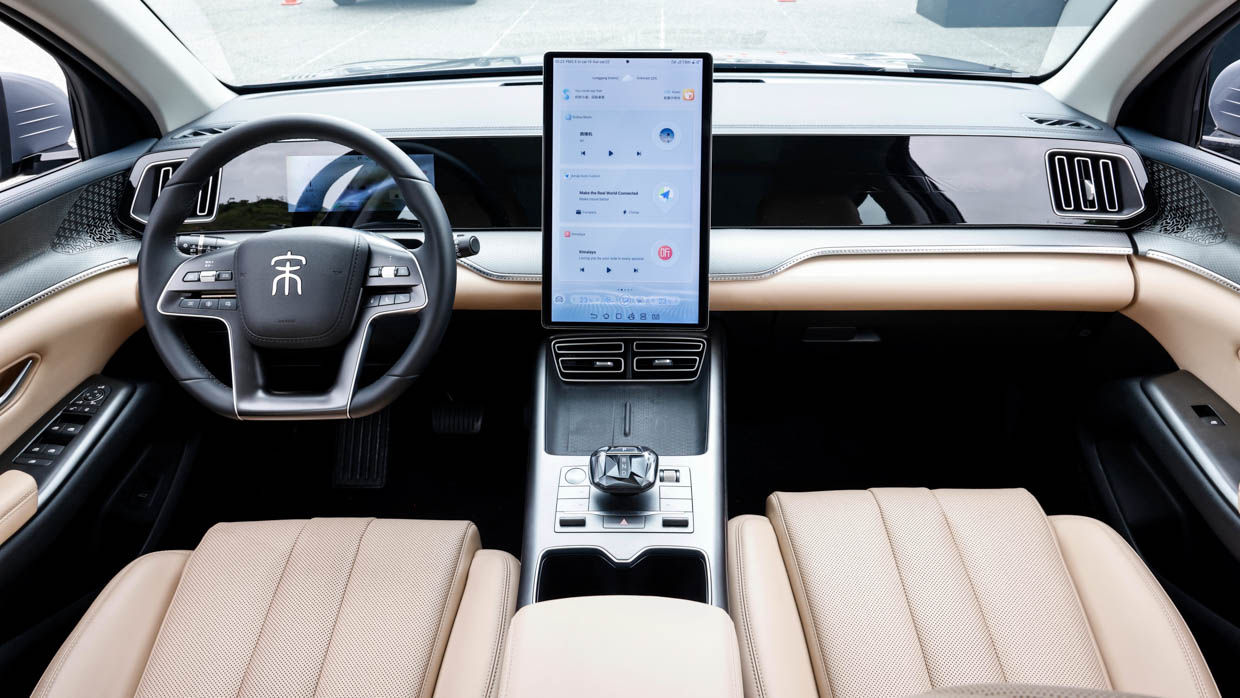
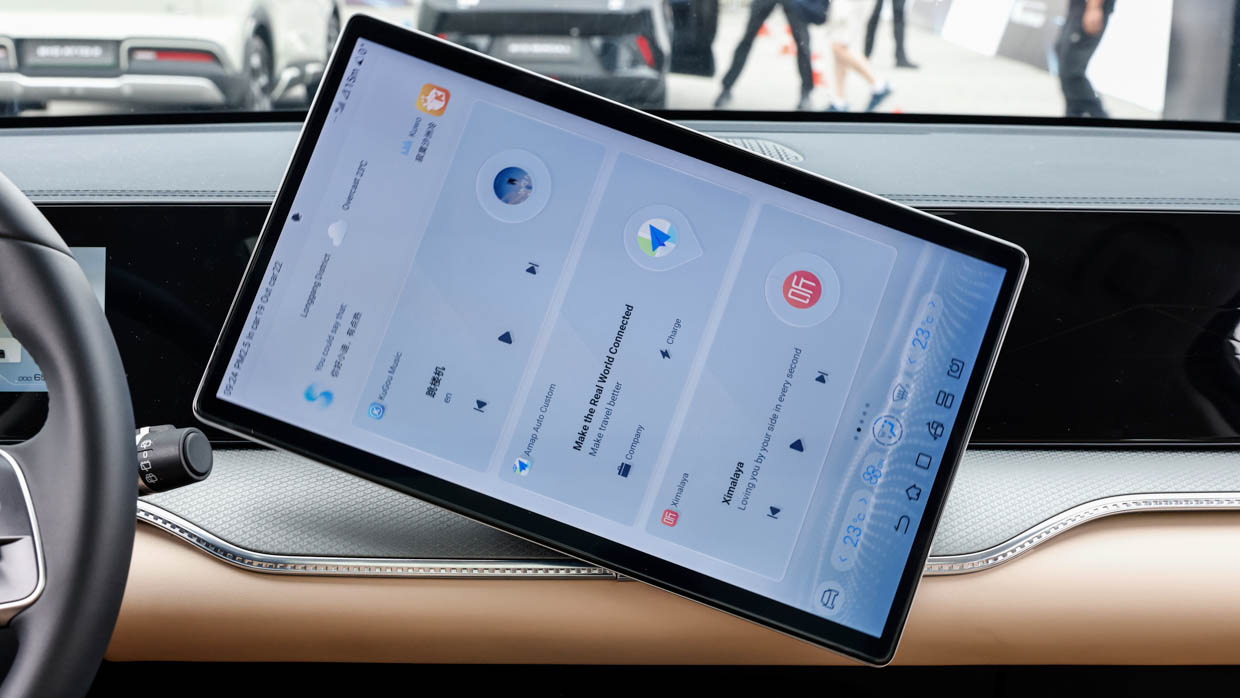
Choosing tan artificial leather upholstery was a good choice, as it shows off how light and airy the Sealion 5’s cabin can be, and hides the shininess of our tester’s black artificial leather. The cream alternative is even brighter.
The centre console has a single wireless charger, along with shortcut buttons for the screen. The ‘crystal’ gear selector was both nice to look at and interact with. Build quality was rather impressive — a common note in all newer BYD products.
Packaging was impressive, too, with a generously-sized rear seat and boot. The flat floor aids rear seat accommodation, while air vents were in the car we sat in along with map pockets.
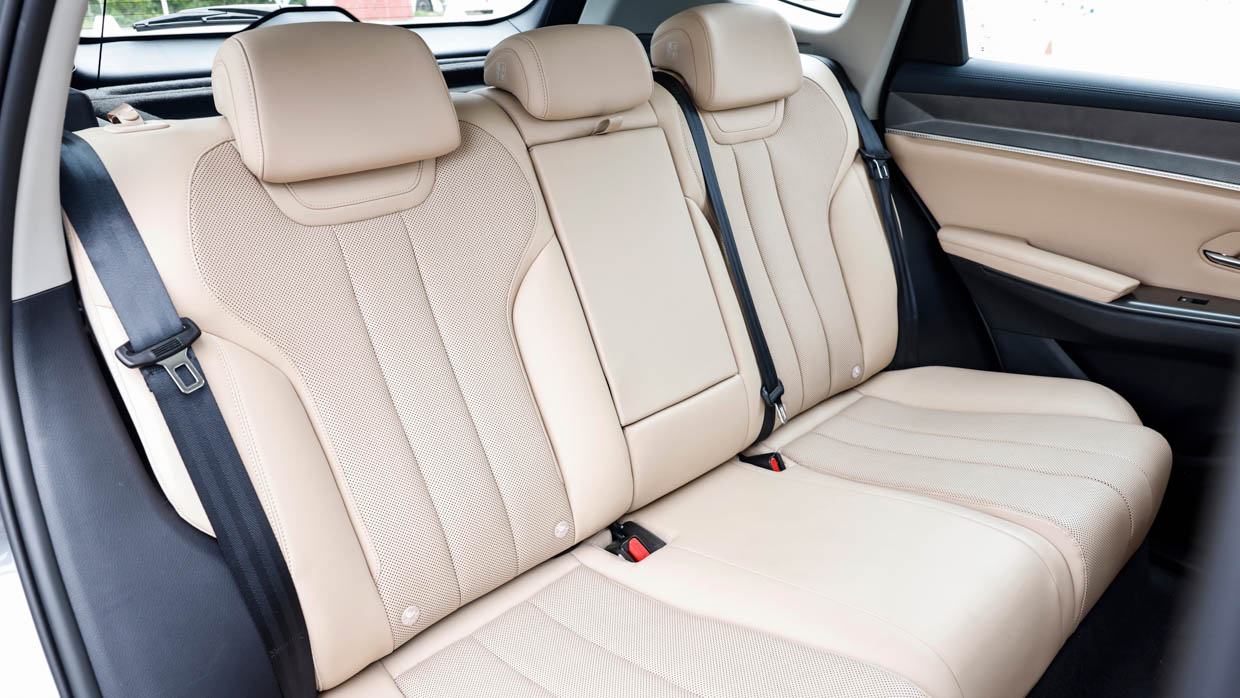
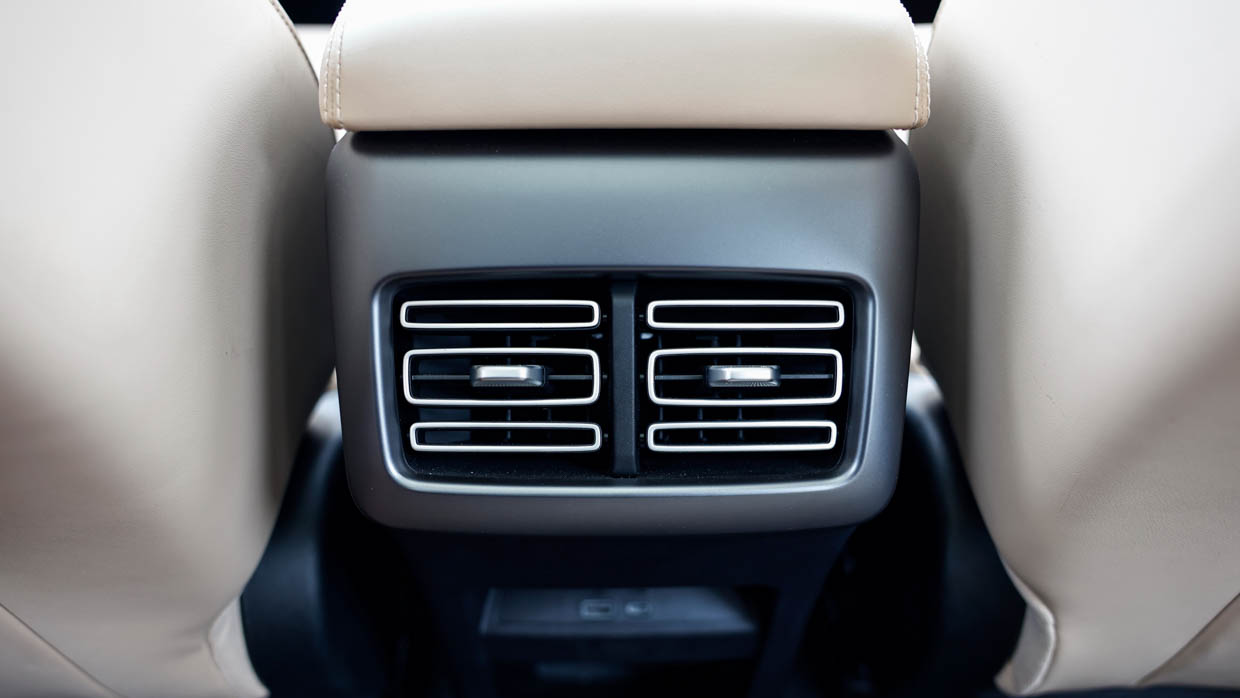
Two battery options are offered globally: a 12.9kWh for a 75 kilometres of claimed electric-only range and a larger 18.3kWh that allows 115km in electric-only mode.
Our drive of the Sealion 5 was brief, and it was the least impressive in terms of punch and suspension satisfaction, riding on simple passive dampers and steel springs with a fairly tall body.
There was a lot of body roll through a slalom test and, like the Sealion 6 in Australia, the 5 in China has featherlight controls, with easy-breezy steering.
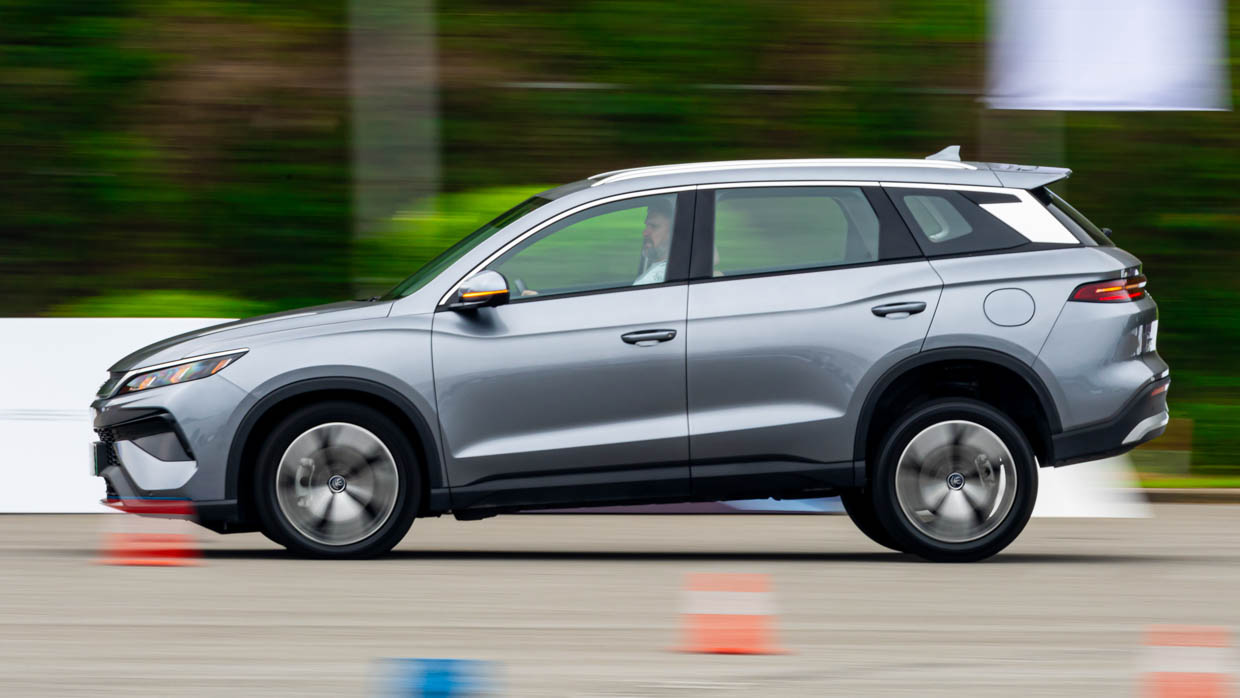
The brake pedal didn’t feel particularly positive. We also noticed a disconnect between the front and rear ends’ ability to absorb bumps.
The Sealion 5 was quiet and more than quick enough to spin up the front tyres, which is not helped by the longitudinal softness and weight transfer under acceleration (and deceleration).
It’s not likely to be the most refined and sophisticated drive experience, then, but as previous encounters with BYD’s PHEVs have proven, it’s likely to be efficient and pretty well calibrated.
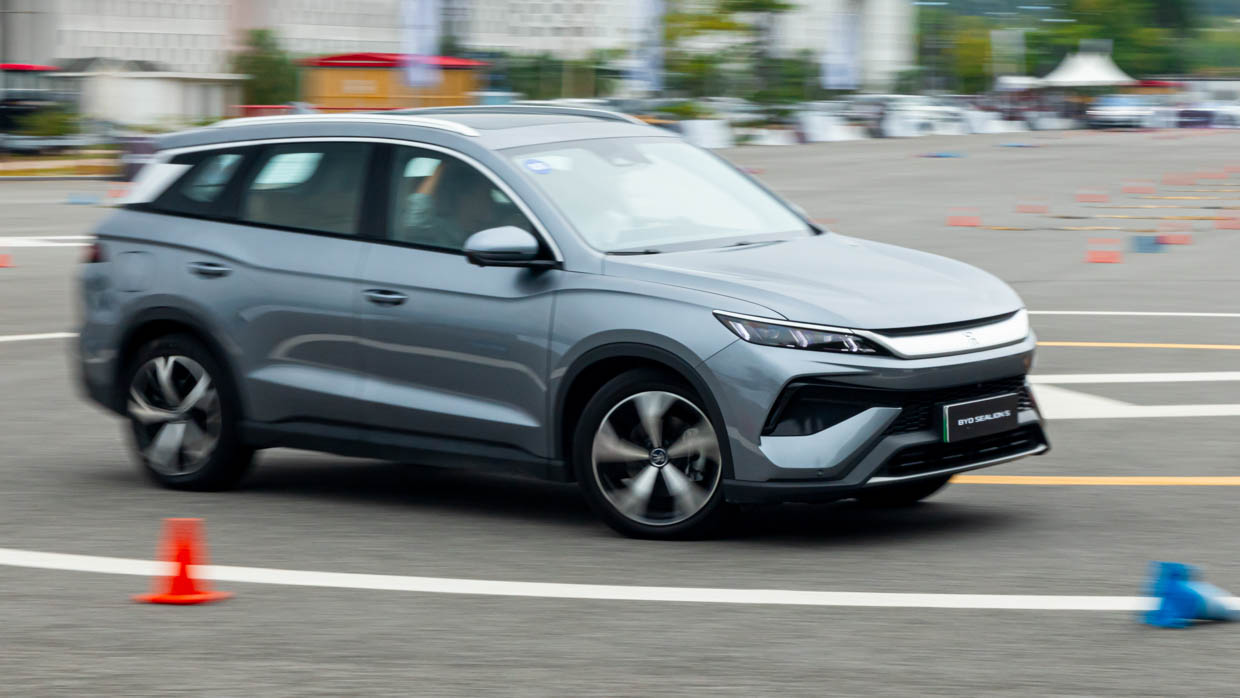
Question remains: should BYD bring it to Australia?
We asked if there was a genuine possibility the Sealion 5 will dip below $40K, before on-roads.
The answer? “We’re not too far off that already with the Sealion 6, you’re only asking for another three grand below that, so I’m sure that’s possible.”
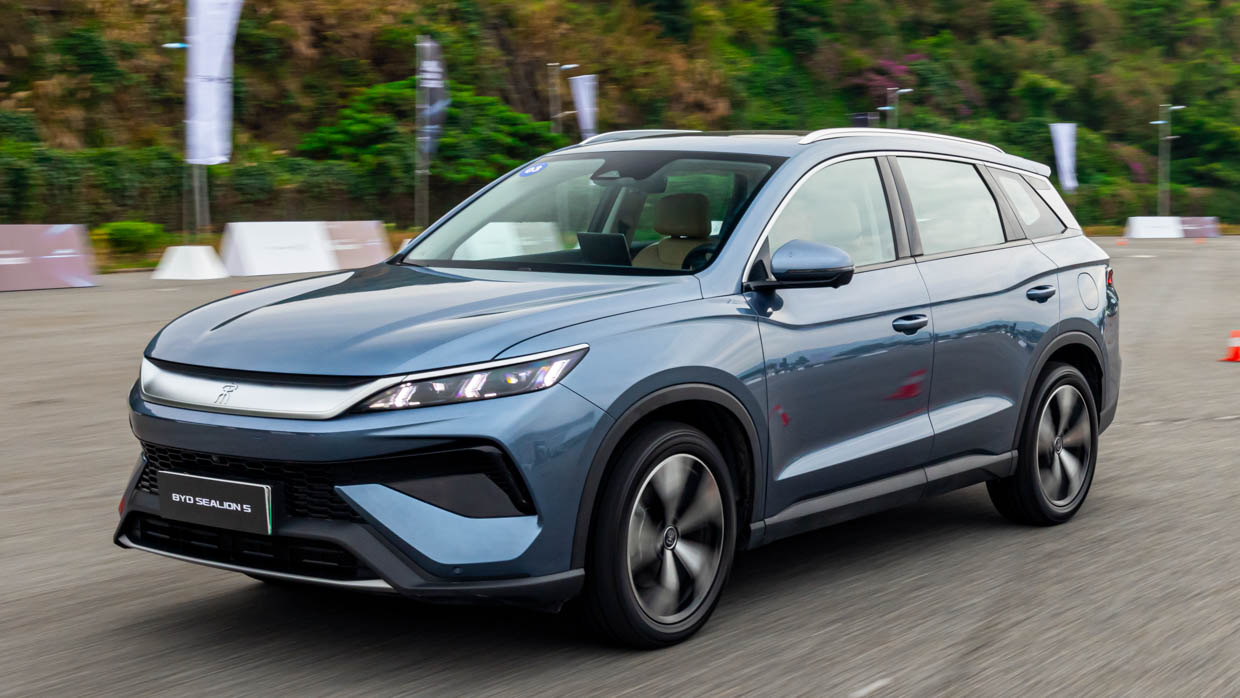
With everyday items costing more by the day, the draw of cheaper cars has seemingly never been stronger. If BYD can deliver a complete, family-friendly product for such a sharp price, then the Sealion 5 has every chance of succeeding.
Chasing more Sealion 5?
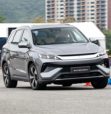
Often compared with
